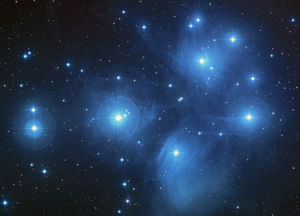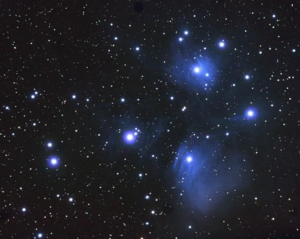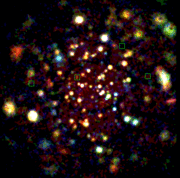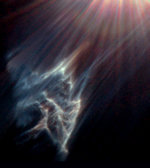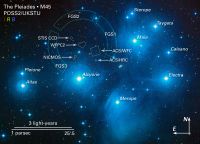Pleiades (star cluster)
2007 Schools Wikipedia Selection. Related subjects: Space (Astronomy)
The Pleiades (also known as M45 or the Seven Sisters) is the name of an open cluster in the constellation of Taurus. It is among the nearest to the Earth of all open clusters, probably the best known and certainly the most striking to the naked eye.
The cluster is dominated by hot blue stars, which have formed within the last 100 million years. Dust that forms faint reflection nebulosity around the brightest stars was thought at first to be left over from the formation of the cluster but is now known to be an unrelated dust cloud that the stars are currently passing through. Astronomers estimate that the cluster will survive for about another 250 million years, after which time it will have dispersed due to gravitational interactions with the spiral arms of the galaxy and giant molecular clouds.
Accurate knowledge of the distance to the cluster is very important in astronomy as it is a crucial first step on the cosmic distance ladder, the calibration of the distance scale of the whole universe. The cluster is now known to lie at a distance of about 135 parsecs (440 light years).
History
The Pleiades are a prominent sight in the Northern Hemisphere in winter and in the Southern Hemisphere in summer, and have been known since antiquity to cultures all around the world, including the Māori and Australian Aborigines, the Japanese, the Aztec and the Sioux of North America. Some Greek astronomers considered them to be a distinct constellation, and they are mentioned by Hesiod, and in Homer's Iliad and Odyssey. They are also mentioned three times in the Bible ( Job 9:9, 38:31; Amos 5:8). The Pleiades (Kartika) are particularly revered in Hindu mythology as the seven mothers of the war god Skanda.
They have long been known to be a physically related group of stars rather than any chance alignment. The Reverend John Michell calculated in 1767 that the probability of a chance alignment of so many bright stars was only 1 in 500,000, and so correctly surmised that the Pleiades and many other clusters of stars must be physically related . When studies were first made of the stars' proper motions, it was found that they are all moving in the same direction across the sky, at the same rate, further demonstrating that they were related.
Charles Messier measured the position of the cluster and included it as M45 in his catalogue of comet-like objects, published in 1771. Along with the Orion Nebula and the Praesepe cluster, Messier's inclusion of the Pleiades has been noted as curious, as most of Messier's objects were much fainter and more easily confused with comets—something which seems scarcely possible for the Pleiades. One possibility is that Messier simply wanted to have a larger catalogue than his scientific rival Lacaille, whose 1755 catalogue contained 42 objects, and so he added some bright, well-known objects to boost his list.
Distance
The distance to the Pleiades is an important first step in the so-called cosmic distance ladder, a sequence of distance scales for the whole universe. The size of this first step calibrates the whole ladder, and the scale of this first step has been estimated by many methods. As the cluster is so close to the Earth, its distance is relatively easy to measure. Accurate knowledge of the distance allows astronomers to plot a Hertzsprung-Russell Diagram for the cluster which, when compared to those plotted for clusters whose distance is not known, allows their distances to be estimated. Other methods can then extend the distance scale from open clusters to galaxies and clusters of galaxies, and a cosmic distance ladder can be constructed. Ultimately astronomers' understanding of the age and future evolution of the universe is influenced by their knowledge of the distance to the Pleiades.
Results prior to the launch of the Hipparcos satellite generally found that the Pleiades were about 135 parsecs away from Earth. Hipparcos caused consternation among astronomers by finding a distance of only 118 parsecs by measuring the parallax of stars in the cluster—a technique which should yield the most direct and accurate results. Later work has consistently found that the Hipparcos distance measurement for the Pleiades was in error, but it is not yet known why the error occurred . The distance to the Pleiades is currently thought to be the higher value of about 135 parsecs , .
Composition
The cluster is about 12 light years in diameter and contains approximately 500 stars in total. It is dominated by young, hot blue stars, up to 14 of which can be seen with the naked eye depending on local observing conditions. The arrangement of the brightest stars is somewhat similar to Ursa Major and Ursa Minor. The total mass contained in the cluster is estimated to be about 800 solar masses.
The cluster contains many brown dwarfs — objects with less than about 8% of the Sun's mass, which are not heavy enough for nuclear fusion reactions to start in their cores and become proper stars. They may constitute up to 25% of the total population of the cluster, although they contribute less than 2% of the total mass . Astronomers have made great efforts to find and analyse brown dwarfs in the Pleiades and other young clusters, because they are still relatively bright and observable, while brown dwarfs in older clusters have faded and are much more difficult to study.
Also present in the cluster are several white dwarfs. Given the young age of the cluster normal stars are not expected to have had time to evolve into white dwarfs, a process which normally takes several billion years. It is believed that, rather than being individual low- to intermediate-mass stars, the progenitors of the white dwarfs must have been high-mass stars in binary systems. Transfer of mass from the higher-mass star to its companion during its rapid evolution would result in a much quicker route to the formation of a white dwarf.
Age and future evolution
Ages for star clusters can be estimated by comparing the H-R diagram for the cluster with theoretical models of stellar evolution, and using this technique, ages for the Pleiades of between 75 and 150 million years have been estimated. The spread in estimated ages is a result of uncertainties in stellar evolution models. In particular, models including a phenomenon known as convective overshoot, in which a convective zone within a star penetrates an otherwise non-convective zone, result in higher apparent ages.
Another way of estimating the age of the cluster is by looking at the lowest-mass objects. In normal main sequence stars, lithium is rapidly destroyed in nuclear fusion reactions, but brown dwarfs can retain their lithium. Due to its very low ignition temperature of 2.5 million kelvins, the highest-mass brown dwarfs will burn lithium eventually, and so determining the highest mass of brown dwarfs still containing lithium in the cluster can give an idea of its age. Applying this technique to the Pleiades gives an age of about 115 million years.
Like most open clusters, the Pleiades will not stay gravitationally bound forever, as some component stars will be ejected after close encounters and others will be stripped by tidal gravitational fields. Calculations suggest that the cluster will take about 250 million years to disperse, with gravitational interactions with giant molecular clouds and the spiral arms of the galaxy also hastening its demise.
Reflection nebulosity
Under ideal observing conditions, some hint of nebulosity may be seen around the cluster, and this shows up in long-exposure photographs. It is a reflection nebula, caused by dust reflecting the blue light of the hot, young stars.
It was formerly thought that the dust was left over from the formation of the cluster, but at the age of about 100 million years generally accepted for the cluster, almost all the dust originally present would have been dispersed by radiation pressure. Instead, it seems that the cluster is simply passing through a particularly dusty region of the interstellar medium.
Studies show that the dust responsible for the nebulosity is not uniformly distributed, but is concentrated mainly in two layers along the line of sight to the cluster. These layers may have been formed by deceleration due to radiation pressure as the dust has moved towards the stars.
Names and technical information
The nine brightest stars of the Pleiades are named for the Seven Sisters of Greek mythology: Sterope, Merope, Electra, Maia, Taygete, Celaeno and Alcyone, along with their parents Atlas and Pleione. As daughters of Atlas, the Hyades were sisters of the Pleiades. The name of the cluster itself is of Greek origin, though of uncertain etymology. Suggested derivations include: from πλεîν plein, to sail, making the Pleiades the "sailing ones"; from pleos, full or many; or from peleiades, flock of doves. The following table gives details of the brightest stars in the cluster:
| Name | Pronunciation ( IPA & respelling) | Designation | Apparent magnitude | Stellar classification |
|---|---|---|---|---|
| Alcyone | /æl'saɪəni/, al-sye'-ə-nee | Eta (25) Tauri | 2.86 | B7IIIe |
| Atlas | /'ætləs/, at'-ləs | 27 Tauri | 3.62 | B8III |
| Electra | /i'lɛktrə/, ee-lek'-trə | 17 Tauri | 3.70 | B6IIIe |
| Maia | /'meɪə, 'maɪə/; may'-ə, mye'-ə | 20 Tauri | 3.86 | B7III |
| Merope | /'mɛrəpi/, mair'-ə-pee | 23 Tauri | 4.17 | B6IVev |
| Taygeta | /tei'ɪʤəti/, tay-ij'-ə-tee | 19 Tauri | 4.29 | B6V |
| Pleione | /'plaɪəni/, plye'-ə-nee | 28 (BU) Tauri | 5.09 (var.) | B8IVep |
| Celaeno | /sə'lino/, sə-lee'-no | 16 Tauri | 5.44 | B7IV |
| Asterope | /ə'stɛrəpi/, ə-stair'-ə-pee | 21 and 22 Tauri | 5.64;6.41 | B8Ve/B9V |
| — | — | 18 Tauri | 5.65 | B8V |
The Pleiades in folklore
The Pleiades' high visibility in the night sky has guaranteed it a special place in many cultures, both ancient and modern. In Greek mythology, they represented the Seven Sisters, while to the Vikings, they were Freyja's hens, and their name in many old European languages compares them to a hen with chicks.
To the Bronze Age people of Europe, such as the Celts (and probably considerably earlier), the Pleiades were associated with mourning and with funerals, since at that time in history, on the cross-quarter day between the autumn equinox and the winter solstice (see Samhain, also Halloween or All Souls Day), which was a festival devoted to the remembrance of the dead, the cluster rose in the eastern sky as the sun's light faded in the evening. It was from this acronychal rising that the Pleiades became associated with tears and mourning. As a result of precession over the centuries, the Pleiades no longer marked the festival, but the association has nevertheless persisted, and accounts for the significance of the Pleiades astrologically.
The ancient Aztecs of Mexico and Central America based their calendar upon the Pleiades. Their calendric year began when priests first remarked the asterism rising heliacally in the east, immediately before the sun's dawn light obliterated the view of the stars.
Heliacal risings very often mark important calendar points for ancient peoples. The heliacal rising of the Pleiades (around June) also begins the new year for the Māori of New Zealand, who call the Pleiades Matariki.
Indigenous Australians
Depending on the tribe or clan, some Indigenous Australian peoples believed the Pleiades were a woman who had been nearly raped by Kidili, the man in the moon.
Another version, often painted by Gabriella Possum Nungurayyi as this is her dreaming (or creation story), daughter of the late Clifford Possum Tjapaltjarri from the Central desert art movement of Papunya, depicts the story of seven Napaltjarri sisters being chased by a man named Jilbi Tjakamarra. He would practice love magic to seduce the sisters but they had no intention of being with him and ran away. They sat down at Uluru to search for honey ants but when they saw Jilbi, they went to Kurlunyalimpa and with the spirits of Uluru, transformed into stars. Jilbi transforms himself into what is commonly known as the Morning Star in Orion's belt, thus continuing to chase the seven sisters across the sky. (Source: Aboriginal Fine Art Gallery)
Native Americans
The Sioux of North America had a legend that linked the origin of the Pleiades to Devils Tower. It was common among the indigenous peoples of the Americas to measure keenness of vision by the number of stars the viewer could see in the Pleiades, a practice which was also used in historical Europe, especially in Greece.
In Japan, the Pleiades are known as Subaru, and have given their name to the car manufacturer. In Chinese constellations, they are 昴 mao, the hairy head of the white tiger of the West, while the name of the Hindu God Kartikeya means him of the Pleiades.
In Western astrology they represent coping with sorrow and were considered a single one of the medieval fixed stars. As such, they are associated with quartz and fennel. In Indian astrology the Pleiades were known as the asterism ( nakshatra) Krittika (which in Sanskrit is translated as "the cutters.") The Pleiades are called the star of fire, and their ruling deity is the Vedic god Agni, the god of the sacred fire. It is one of the most prominent of the nakshatras, and is associated with anger and stubbornness.
The word has acquired a meaning of "multitude", inspiring the name of the French literary movement La Pléiade and an earlier group of Alexandrian poets, the Alexandrian Pleiad.
